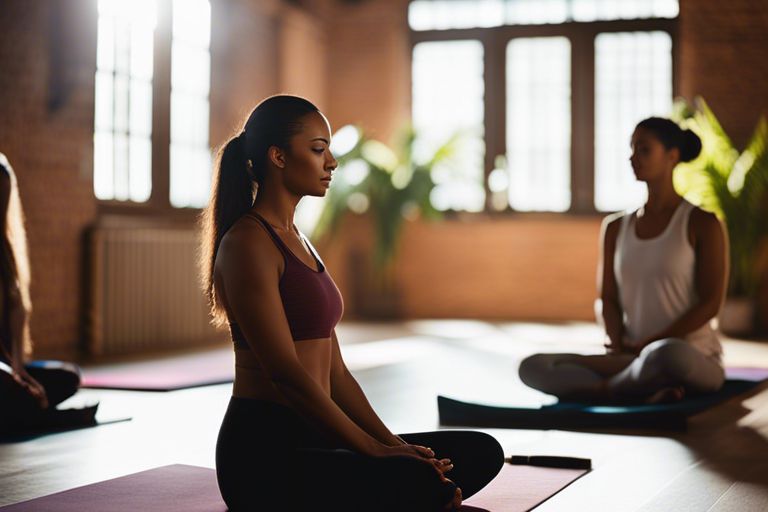Asana, the physical practice of yoga poses, is just the tip of the iceberg when it comes to the ancient philosophy and art of yoga. In this blog post, we will investigate into the core elements of yoga beyond the physical poses, including pranayama, the practice of breath control. Understanding the deeper layers of yoga can help practitioners cultivate a more holistic and profound spiritual connection, enhancing their overall well-being and inner peace.
Key Takeaways:
- Asana is just one part of yoga: While asana (physical postures) is a well-known aspect of yoga, it is important to remember that yoga encompasses a wider range of practices including pranayama (breath control), meditation, and ethical principles.
- Pranayama is vital for overall well-being: Breathing techniques in pranayama can help reduce stress, improve focus, and enhance energy levels. It plays a crucial role in balancing the body’s nervous system and promoting a sense of calm and relaxation.
- Combining asana and pranayama enhances yoga practice: Integrating physical postures with breathwork creates a holistic yoga practice that not only strengthens the body but also calms the mind. This synergy allows individuals to experience the full benefits of yoga on a physical, mental, and emotional level.

The Historical Roots of Yoga
The Origin and Evolution of Yoga
Before delving into the intricate layers of yoga practice, it is crucial to understand its historical roots. Yoga, derived from the Sanskrit word “Yuj,” meaning to unite or join, has a history that dates back thousands of years. The practice of yoga can be traced to ancient India, where it emerged as a spiritual discipline aimed at harmonizing the body, mind, and spirit.
With time, yoga evolved, branching into various schools and styles, each with its unique emphasis and practices. From the rigorous physical postures of Hatha Yoga to the meditative focus of Raja Yoga, the evolution of yoga reflects the diverse paths toward spiritual awakening and self-realization.
Key Philosophies and Texts
For a comprehensive understanding of yoga, one must research into its key philosophies and texts. The foundational text of yoga is the Yoga Sutras of Patanjali, a collection of aphorisms that outline the path of Ashtanga Yoga, or the Eight Limbs of Yoga. These limbs include ethical practices, physical postures, breath control, and meditation, all aimed at achieving spiritual liberation.
The Bhagavad Gita, another crucial text, researchs into the concept of duty and righteousness within the framework of yoga. This sacred scripture explores the idea of selfless action and the pursuit of inner harmony amidst life’s challenges, offering profound insights into the yogic way of life.
For a deeper exploration of the philosophies and texts that underpin yoga practice, one can study the Upanishads, ancient philosophical texts that research into the nature of reality and the self. These texts offer profound insights into the interconnectedness of all life and the ultimate purpose of human existence.
Asana – The Foundation of Physical Practice
Some of the core elements of yoga practice revolve around the physical postures known as asanas. These poses are the foundation of the physical practice of yoga and play a vital role in promoting strength, flexibility, balance, and overall well-being.
Understanding Asana and Its Purpose
With origins rooted in ancient Indian traditions, asanas are physical postures designed to align the body and create a sense of balance and harmony. The word “asana” translates to “seat” in Sanskrit, reflecting the intention of finding a steady and comfortable position for meditation.
Asanas are not merely exercises but are intended to be practiced mindfully, focusing on the breath, alignment, and the present moment. By practicing asanas regularly, individuals can cultivate self-awareness, reduce stress, and improve physical and mental health.
Types and Categories of Asanas
One of the defining features of yoga is the vast variety of asanas that cater to different levels of proficiency and serve various purposes. Asanas are typically categorized into groups based on their benefits, such as standing poses, seated poses, backbends, inversions, and twists.
| Standing Poses | Help improve balance, strength, and focus. |
| Seated Poses | Promote flexibility in the hips and lower back. |
| Backbends | Open the chest and improve spinal flexibility. |
| Inversions | Boost circulation and provide a new perspective. |
| Twists | Aid in digestion and detoxification. |
After mastering the foundational poses, practitioners can progress to more challenging variations based on their goals and abilities. It’s necessary to listen to the body, practice with awareness, and seek guidance from experienced teachers to avoid injury and maximize the benefits of each asana.

Beyond the Physical: The Eight Limbs of Yoga
The Yamas and Niyamas: Ethical Practices
Despite the popular emphasis on yoga’s physical postures, the practice encompasses a comprehensive philosophy known as the Eight Limbs, as outlined by the sage Patanjali. The first two limbs, the Yamas and Niyamas, serve as ethical guidelines for personal conduct and self-discipline.
Eight foundational principles guide the Yamas and Niyamas, focusing on attitudes and behaviors that cultivate a harmonious relationship with oneself and others. Practicing these ethical restraints and observances not only shapes one’s character but also lays the groundwork for a balanced and conscious life.
Pranayama: Mastering the Breath
For practitioners seeking to deepen their yoga practice, mastering the art of breath control through Pranayama is imperative. This limb of yoga focuses on regulating the breath to increase vitality, clear the mind, and connect with the present moment.
Through various breathing techniques, practitioners learn to harness the power of the breath to balance the body’s energy systems and cultivate a sense of inner peace. Consistent practice of Pranayama not only enhances physical well-being but also serves as a bridge between the physical and the spiritual aspects of yoga.
To investigate deeper into the practice of Pranayama, individuals can explore techniques such as Ujjayi breath, Kapalabhati breathing, and Nadi Shodhana. These practices not only enhance lung capacity and oxygen intake but also calm the mind and prepare it for meditation.
Pratyahara and Dharana: Withdrawal and Concentration
Mastering the stages of Pratyahara (sensory withdrawal) and Dharana (concentration) are crucial steps in the journey towards inner exploration and self-awareness. Pratyahara involves turning the senses inward, detaching from external distractions, and fostering a deeper connection with one’s internal landscape.
By honing the ability to concentrate through Dharana, individuals can focus the mind on a single point, object, or thought. This practice cultivates mental clarity, enhances self-discipline, and lays the groundwork for deeper introspection and meditative states.
Dhyana and Samadhi: Meditation and Enlightenment
Beyond the physical postures and breathing techniques, the limbs of Dhyana (meditation) and Samadhi (enlightenment) represent the pinnacle of the yogic journey. Regular meditation practice in Dhyana allows practitioners to cultivate a focused and tranquil mind, leading to a profound sense of inner peace and self-realization.
Samadhi, the final limb of yoga, signifies the state of transcendence where the practitioner experiences union with the divine or the ultimate reality. This state of enlightenment is characterized by a profound sense of oneness, deep inner peace, and liberation from the limitations of the ego.
Pratyahara, Dharana, Dhyana, and Samadhi collectively represent the internal aspects of yoga practice that transcend the physical body, offering a path towards self-discovery, spiritual growth, and the realization of one’s true nature.
Integrating Yoga into Daily Life
Now more than ever, integrating yoga into daily life is becoming increasingly important to maintain balance, peace, and well-being. By incorporating yoga practices into our routines, we can cultivate mindfulness, improve physical health, and enhance mental clarity.
Developing a Personal Practice
Practice is the key to unlocking the transformative power of yoga. Developing a personal practice involves setting aside dedicated time each day to engage in yoga poses, breathwork, and meditation. Whether it’s a short morning flow or a calming evening practice, consistency is necessary to benefit from the holistic effects of yoga on the body, mind, and spirit.
The beauty of a personal practice is that it can be tailored to suit individual needs and goals. By exploring different styles of yoga, such as Hatha, Vinyasa, or Yin, practitioners can discover what resonates best with them and create a routine that nurtures their unique strengths and areas for growth.
Yoga for Wellness and Lifestyle
The integration of yoga into daily life extends beyond the physical practice on the mat. Yoga for wellness encompasses a holistic approach to health, encouraging mindful eating, self-care practices, and stress management techniques. By embracing the yogic principles of ahimsa (non-harming), satya (truthfulness), and santosha (contentment), individuals can cultivate a lifestyle that promotes overall well-being and fulfillment.

Final Words
As a reminder, the core elements of yoga – asana, pranayama, and meditation – form a harmonious practice that promotes physical, mental, and spiritual well-being. By incorporating these elements into your routine, you can cultivate strength, flexibility, and inner peace. Remember to approach your practice with dedication, mindfulness, and respect for your body’s limitations. Whether you’re a beginner or an experienced practitioner, embracing these core elements will guide you on a transformative journey towards self-discovery and holistic health. Keep exploring, growing, and nurturing your inner yogi as you probe deeper into the profound teachings of yoga.
FAQ
Q: What is the significance of ‘From Asana to Pranayama – Exploring the Core Elements of Yoga’?
A: ‘From Asana to Pranayama – Exploring the Core Elements of Yoga’ is a transformative journey that investigates into the fundamental components of yoga practice, offering a comprehensive understanding of both physical postures and breath control.
Q: What are Asanas in yoga?
A: Asanas, or yoga postures, are physical positions designed to promote strength, flexibility, and balance in the body. Practicing asanas helps to create a harmonious union between the body, mind, and spirit.
Q: What is Pranayama?
A: Pranayama refers to the practice of breath control in yoga. Through various breathing techniques, pranayama aims to regulate the flow of prana (life force energy) in the body, leading to physical and mental well-being.
Q: How do Asanas and Pranayama work together in yoga practice?
A: Asanas prepare the body for pranayama practice by building strength, flexibility, and concentration. When combined, these core elements of yoga create a holistic experience that enhances vitality, clarity, and inner peace.
Q: What are the benefits of exploring the core elements of yoga?
A: By delving into ‘From Asana to Pranayama – Exploring the Core Elements of Yoga’, individuals can deepen their yoga practice, cultivate mindfulness, reduce stress, improve physical well-being, and ultimately experience a profound sense of unity within themselves and the world around them.

